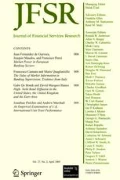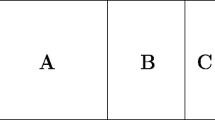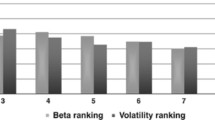Abstract
This is the first study in a large European market which analyzes monthly portfolios to obtain evidence of equity fund trading around quarterly reports. A new portfolio-weight approach shows that managers disclose large-cap and well-known stocks with higher returns and hide the same return-loser stocks in the reporting months. A fund-size agency problem plays an important role in this window dressing evidence. Fund trading also shows that managers benefits from the January effect by buying small-cap stocks at the beginning of the year rather than causing this anomaly.
Similar content being viewed by others
Notes
This window dressing phenomenon has also been tested for other financial institutions i.e. for the balance sheet activity in banks (Kotomin and Winters, 2006).
European Council Directive 2001/107/EC of 21 January 2002 partially amends Directive 85/611/EEC of 20 December 1985 on the coordination of laws, regulations and administrative provisions relating to Undertakings for Collective Investment in Transferable Securities (UCITS).
According to the Spanish Collective Investment and Pension Funds Association (INVERCO), the number of Spanish domestic equity funds stood at 122 out of 2,794 existing in the Spanish mutual fund industry at the end of 2006, which represents about 5% of assets under management of the overall market. Despite this low fraction, it is important to note that this domestic category is the most active participant of the fund industry in the Spanish stock exchange markets, holding more than 50% of the total assets invested by mutual funds in Spanish stocks. This result explains the relevance of this fund category to analyze mutual fund trading. Detailed statistics are available upon request.
One may think why mutual fund managers disclose the monthly tape of their potential manipulation if they are aware that these reports will be probed by CNMV, and scrutinized by researchers. There are two main arguments that approve the validity of the database. First, as far as we know, the use of this information was unique and exclusive for the authors of this paper. Further applications to update this confidential information were rejected by the regulator, which questions whether managers might be aware of potential data analyses. Second, the systematic intra-month portfolio manipulation could involve important and additional transaction costs for equity funds in the case of removing any window dressing evidence from monthly disclosures.
The remaining holdings average less than 25% of the portfolio sample and contain a wide range of foreign stocks, investment societies, and other mutual fund units. The study does not analyze these assets because of both the assorted nature of them, and the residual impact on the investment goal of domestic equity funds, which is focused on Spanish common stocks.
There are not significant differences in the percentages displayed by Table 1 between quarter-end portfolios vs. other month-end portfolios. Detailed information is available upon request.
This low percentage might suggest that other Spanish fund categories could largely increase this figure. However, according to additional statistics that are not reported in this study, the Spanish fund industry owns about 7% of the Spanish stock capitalization (December 2006).
These daily asset returns are calculated from different datasets of daily closing prices. These returns are adjusted by dividends, stock splits and seasoned equity offerings. Spanish stock data are obtained from the Madrid Stock Exchange and European stock data are provided by Reuters DataLink. Fixed-income daily returns are provided by Analistas Financieros Internacionales (AFI). Finally, a low percentage of fund total assets (about 3%) are non-controlled securities, which together with cash and cash equivalents receive a zero return.
We obtain Fama-MacBeth standard errors, White consistent standard errors, and OLS standard errors clustered by fund, by time, and by both fund and time. According to Petersen (2008), the comparison of these panel data standard errors leads us to accept the existence of a time effect in the panel data regression for the full sample. This effect may be controlled by using the correct confidence intervals based on the Fama-MacBeth and OLS standard errors clustered by time. However, the same procedure rejects any fund and time effect when the most aggressive intra-quarter funds are considered in the panel data regression. Detailed information regarding the standard error estimates is available on request.
Both hypotheses were tested at 95% confidence interval. The mean comparison test uses Welch’s approximation to degrees of freedom due to the rejection of equal variance hypothesis. Detailed results of these tests are available upon request. Further studies should verify in much more detail the consequences of portfolio manipulation in terms of return and risk but this objective is beyond the goals of our paper.
The ten largest out of the 102 Spanish fund companies existing in December 2006 managed more than 70% of the total assets of the Spanish fund industry. The average fund size in Spain was about 89 million € while the average fund size in the European industry was about 160 million € (Source: Inverco and European Fund and Asset Management Association, International Statistical Release 2006:Q4).
Total fund assets and 3-month returns are officially provided by CNMV. The age of the funds is computed in days since the inception dates officially registered in the CNMV.
According to section 3.1, the change of the portfolio image is better represented by the estimates of the portfolio weight ratios (Equations 8 and 9). Table 4 omits the estimates of the trading activity ratios (Equations 6 and 7) previously displayed in Table 3 for the sake of brevity but this information is available upon request.
Descriptive statistics of the market concentration of the sample are available upon request.
We also run panel data regressions to test the robustness of the interaction between specific fund characteristics and portfolio weight ratios (Equations 8 and 9). According to Petersen (2008), we identify the correlations between the residuals across funds by comparing the standard errors obtained via the different panel data methods. The results are consistent with the evidence reported by Table 4. Detailed statistics are available upon request.
The sum of C+ January and C- January is a conservative measure of the trading volume in January because it omits the intra-January round-trip trades. However, according to Elton et al. (2010) this intra-month bias is expected to be small because of the high transaction costs assumed by these trades. Total Spanish market trading has been obtained from the Official Bulletins of the Spanish Stock Market. Detailed figures are omitted for the sake of brevity.
References
Ackert LF, Athanassakos G (2000) Institutional investors, analyst following, and the january anomaly. J Bus Finance Account 27(3–4):469–485
Agarwal V, Jiang W, Tang Y, Yang B (2013) Uncovering hedge fund skill from the portfolio holdings they hide. J Finance 68(2):739–783
Bernhardt D, Davies RJ (2005) Painting the tape: aggregate evidence. Econ Letters 89(3):306–311
Brown KC, Harlow WV, Starks LT (1996) Of tournaments and temptations: an analysis of managerial incentives in the mutual fund industry. J Finance 51(1):85–110
Carhart MM, Kaniel R, Musto D, Reed AV (2002) Leaning for the tape: evidence of gaming behavior in equity mutual funds. J Finance 57(2):661–693
Dyl EA (1977) Capital gains taxation and year-end stock market behavior. J Finance 32(1):165–175
Elton EJ, Gruber MJ, Blake CR (2012) An examination of mutual fund timing ability using monthly holding data. Rev Finance 16(3):619–645
Elton EJ, Gruber MJ, Blake CR, Krasny Y, Ozelge SO (2010) The effect of holdings data frequency on conclusions about mutual fund behavior. J Banking Financ 34:912–922
Gallagher DR, Gardner P, Swan PL (2009) Portfolio pumping: an examination of investment manager quarter-end trading and impact on performance. Pacific-Basin Financ J 17:1–27
Haugen RA, Lakonishok J (1988) The incredible january effect: the stock market’s unsolved mystery. Dow-Jones-Irwin, Homewood, III
He J, Ng L, Wang Q (2004) Quarterly trading patterns of financial institutions. J Bus 77(3):493–509
Ippolito RA (1992) Consumer reaction to measures of poor quality: evidence from the mutual fund industry. J Law Econ 35(1):45–70
Kacperczyk M, Sialm C, Zheng L (2008) Unobserved actions of mutual funds. Rev Financ Stud 21(6):2379–2416
Kotomin V, Winters DB (2006) Quarter-End effects in banks: preferred habitat or window dressing. J Financ Serv Res 29(1):61–82
Lakonishok J, Shleifer A, Thaler R, Vishny R (1991) Window dressing by pension fund managers. Amer Econ Rev 81(2):227–231
Lee C, Porter DC, Weaver DG (1998) Indirect tests of the haugen-Lakonishok small-firm/january effect hypotheses: window dressing versus performance hedging. Financ Rev 33(2):177–194
Liao T-L, Huang C-J, Wu C-Y (2010) Do fund managers herd to counter investor sentiment? J Bus Res 64(2):207–212
Meier I, Schaumburg E (2006) Do funds window dress? Evidence for U.S. domestic equity mutual funds. Northwestern University
Morey MR, O’Neal ES (2006) Window dressing in bond mutual funds. J Financ Res 29(3):325–347
Musto D (1997) Portfolio disclosures and year-end price shifts. J Financ 52(4):1563–1588
Musto D (1999) Investment decisions depend on portfolio disclosures. J Financ 54(3):935–952
Ng L, Wang Q (2004) Institutional trading and the turn-of-the-year effect. J Financ Econ 74:343–366
Ortiz C, Ramírez G, Vicente LA (2010) Quarterly return patterns in the spanish stock market. Appl Financ Econ 20(23):1829–1838
Ortiz C, Sarto JL, Vicente LA (2012) Portfolios in disguise? window dressing in bond fund holdings. J Bank Financ 36:418–427
Petersen MA (2008) Estimating standard errors in finance panel data sets: comparing approaches. Rev Financ Stud 22:435–480
Sias RW, Starks LT (1997) Institutions and individuals at the turn-of-the-year. J Finance 52(4):1543–1562
Sirri ER, Tufano P (1998) Costly search and mutual fund flows. J Financ 53(5):1589–1622
Acknowledgments
The authors thank the UCEIF Foundation, research project ECO2009-12819-C03-02 of the Spanish Department of Science, and research project 268–159 of the University of Zaragoza for their financial support. We appreciate insightful comments from David Musto (editor) and the anonymous referee, Manuel Armada, Alexander Kempf, Van Thi Tuong Nguyen, Auke Plantinga, José Luis Sarto, and the participants of the EFMA 2011 annual meeting. Any possible errors in this article are the exclusive responsibility of the authors.
Author information
Authors and Affiliations
Corresponding author
Rights and permissions
About this article
Cite this article
Ortiz, C., Ramírez, G. & Vicente, L. Mutual Fund Trading and Portfolio Disclosures. J Financ Serv Res 48, 83–102 (2015). https://doi.org/10.1007/s10693-014-0198-2
Received:
Revised:
Accepted:
Published:
Issue Date:
DOI: https://doi.org/10.1007/s10693-014-0198-2




